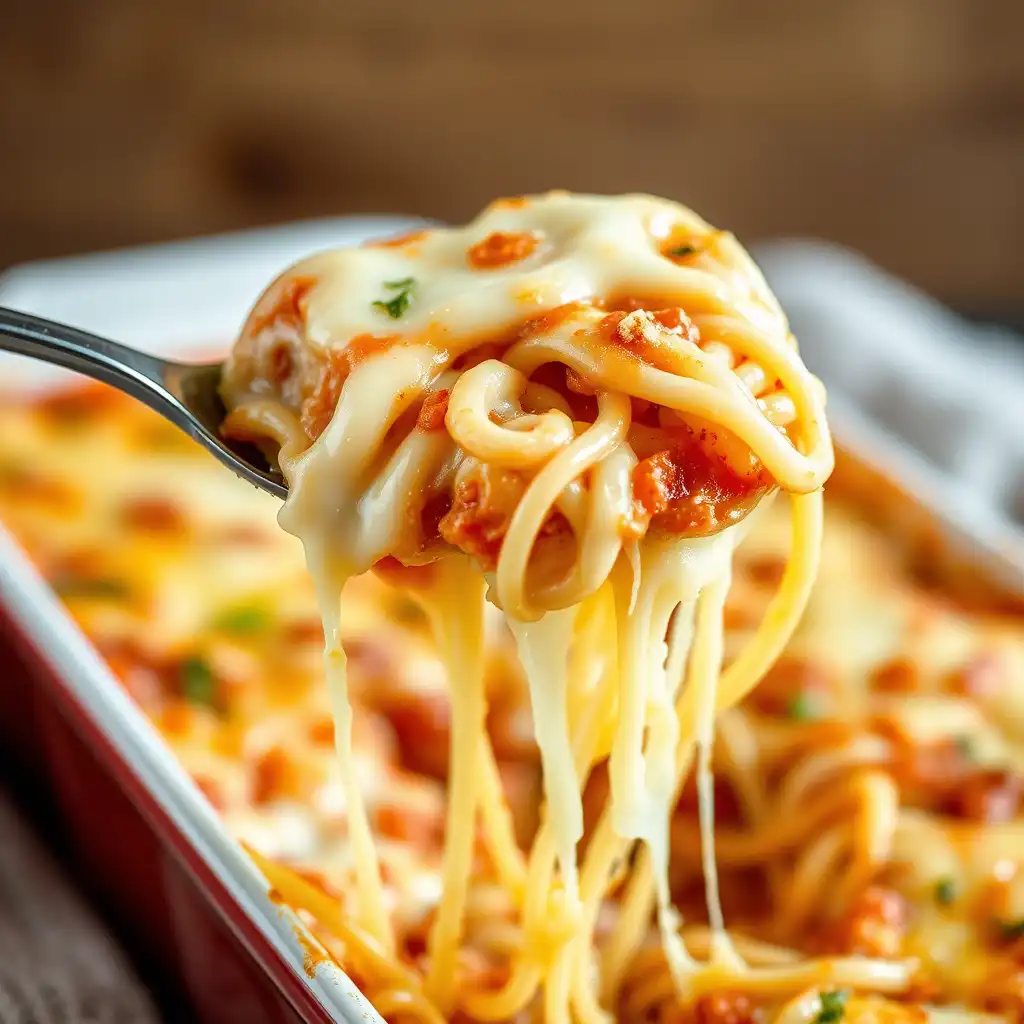Baked Cream Cheese Spaghetti Casserole is one of those dishes that feels like a warm blanket on a cold night. The kind of food you pull out of the oven and the whole house just smells like family gathered around the table. It’s got the heartiness of classic spaghetti, but then cream cheese sneaks in and transforms the whole texture into this silky, rich, almost luxurious thing. Strange how such a humble pantry pasta suddenly feels like Sunday dinner in a fancy trattoria.
Baked Cream Cheese Spaghetti Casserole is special because it straddles the line between Italian-American comfort food and southern-style casseroles. It takes the crowd-pleasing nature of baked pasta and adds this unexpected tang and creaminess from the cream cheese. What’s remarkable is how it’s both rustic and indulgent at once—like a hybrid of lasagna and baked ziti, but faster, easier, more forgiving.
Ingredients & Substitutions
Baked Cream Cheese Spaghetti Casserole starts, naturally, with spaghetti. A standard durum wheat pasta works fine, but higher-protein spaghetti (around 13–14%) holds structure better during baking. If gluten-free is needed, use a rice and corn blend pasta, but cook it slightly under al dente or it’ll collapse in the oven.
Baked Cream Cheese Spaghetti Casserole then leans on cream cheese. Full-fat cream cheese is non-negotiable if you want that signature velvety layer. Reduced-fat versions split under heat and taste flat. Goat cheese is a playful substitute if you want tangier character, while ricotta gives you a softer, lighter profile—though it won’t cling the same way.
Baked Cream Cheese Spaghetti Casserole needs ground beef or Italian sausage for body. Beef provides that neutral richness, but Italian sausage with fennel seeds makes the dish sing. Turkey or chicken work if you want leaner meat, but you’ll need to boost flavor with smoked paprika or Worcestershire. Vegetarians can sub in sautéed mushrooms, lentils, or even crumbled tempeh—it won’t taste identical, but the textural chew helps mimic meat.
Baked Cream Cheese Spaghetti Casserole relies on marinara sauce, and here’s where quality counts. A homemade tomato sauce made from San Marzano tomatoes gives a clean sweetness and acidity balance. If store-bought, pick one with olive oil as the base fat, not soybean oil—it holds flavor under long baking. For a punchier, rustic profile, stir in a spoon of tomato paste for depth.
Baked Cream Cheese Spaghetti Casserole gets fragrance from garlic, onion, and dried herbs. Fresh garlic blooms differently than garlic powder—it caramelizes into sweet nuttiness, while powder blends into the sauce. Dried oregano and basil hold up better during baking than fresh herbs, which lose intensity. Add fresh parsley or basil right before serving for brightness.
Baked Cream Cheese Spaghetti Casserole wouldn’t feel complete without cheese topping. Mozzarella gives you that stretchy pull, Parmesan brings nutty sharpness, and provolone adds smoky undertones. If you want a sharper kick, Asiago or Fontina can step in. Dairy-free eaters can use cashew mozzarella shreds, though they won’t brown quite the same.
Step-by-Step Instructions
Baked Cream Cheese Spaghetti Casserole begins by boiling pasta. Salt the water aggressively—think ocean water—because pasta only absorbs flavor once. Cook spaghetti to one minute less than package al dente; it will finish cooking in the oven. Overcooking now means mushy noodles later, and nobody’s craving casserole mush.
Baked Cream Cheese Spaghetti Casserole needs a sauce base. Brown your ground beef or sausage in a heavy skillet, medium-high heat. Don’t rush it—let it sit untouched for a minute so caramelization develops. That browned fond stuck to the bottom? That’s gold. Deglaze with a splash of red wine if you’ve got it; it builds layers of flavor in seconds.
Baked Cream Cheese Spaghetti Casserole moves next to the creamy layer. Once pasta is drained, toss it hot with softened cream cheese. The heat melts it into a glossy coat, clinging to every strand. If the cheese clumps, it means your cream cheese was too cold—leave it at room temp for at least 30 minutes before using.
Baked Cream Cheese Spaghetti Casserole then assembles like a lasagna but quicker. Spread a thin layer of meat sauce at the bottom of your baking dish. Layer in the cream cheese spaghetti, then more sauce, then mozzarella and Parmesan. Repeat once more if using a deep dish, or stick to a single thick layer for simplicity.
Baked Cream Cheese Spaghetti Casserole bakes covered at 350°F (175°C) for 25 minutes. The foil traps moisture so the pasta doesn’t dry. Remove foil and bake another 15 minutes to let cheese blister and brown. If the top isn’t caramelized enough, a 2-minute broil will finish it off—watch it like a hawk, cheese burns fast.
Baked Cream Cheese Spaghetti Casserole needs a rest. Let it sit 10 minutes before slicing. The cooling period firms layers so it doesn’t collapse when serving. It’s painful to wait when the kitchen smells like melted cheese heaven, but patience pays off in clean, sturdy servings.
Cooking Techniques & Science
Baked Cream Cheese Spaghetti Casserole works because of fat distribution. Cream cheese emulsifies into pasta, coating every strand so sauce doesn’t sink to the bottom. Without it, baked spaghetti often separates into dry pasta clumps swimming in sauce.
Baked Cream Cheese Spaghetti Casserole benefits from Maillard reaction on the meat. That browning creates hundreds of new flavor compounds, giving depth no amount of dried herbs can replicate. Professionals know caramelization is the invisible backbone of flavor. Skipping this step leads to a flat, one-note casserole.
Baked Cream Cheese Spaghetti Casserole transforms texturally under oven heat. The top cheese layer undergoes thermal polymerization, forming that golden crust. The contrast between crispy top and creamy interior is what keeps diners going back for seconds. Too much moisture and you lose this effect, so drain pasta well and don’t flood with watery sauce.
Baked Cream Cheese Spaghetti Casserole requires the right tools. A ceramic or enameled baking dish retains heat evenly, ensuring steady bake. Glass heats faster but cools unevenly. Metal pans brown edges quicker, but risk scorching unless monitored. For serving, a sharp-edged spatula is essential to lift clean slices without tearing pasta.
Serving & Pairing Suggestions
Baked Cream Cheese Spaghetti Casserole deserves to be served in generous squares, with the layers clearly visible. Sprinkle with fresh parsley or basil just before plating—the pop of green against molten cheese makes it restaurant-worthy. A drizzle of olive oil or a dusting of chili flakes can elevate it further.
Baked Cream Cheese Spaghetti Casserole pairs beautifully with sides that cut richness. A crisp green salad with a vinaigrette balances the creamy weight. Garlic bread is the classic choice, doubling down on comfort food territory. Roasted vegetables like zucchini or bell peppers also provide balance without competing flavors.
Baked Cream Cheese Spaghetti Casserole matches well with drinks. A medium-bodied red like Chianti or Merlot enhances the tomato base. For a white, try a buttery Chardonnay to complement cream cheese’s tang. Non-alcoholic? Sparkling water with lemon cleans the palate between bites.
Conclusion
Baked Cream Cheese Spaghetti Casserole is not just another baked pasta—it’s a masterclass in how one ingredient can completely redefine texture and character. Cream cheese turns familiar spaghetti into a creamy, indulgent, and unforgettable dish. It’s versatile, adaptable, and forgiving, making it a reliable centerpiece for family dinners, potlucks, or even professional catering where consistency matters.
Baked Cream Cheese Spaghetti Casserole thrives on technique—season pasta water, caramelize meat, rest before slicing. Small details separate a good casserole from an exceptional one. That’s the beauty of it: a dish so simple on paper, but endlessly nuanced in execution.
FAQs
How do I keep baked cream cheese spaghetti casserole from drying out?
Cover the dish with foil for most of the baking time. This traps steam and keeps pasta moist, then remove foil at the end for browning.
Can I make baked cream cheese spaghetti casserole ahead of time?
Yes, assemble it up to a day in advance and refrigerate. Bake 10–15 minutes longer if going straight from cold.
Can baked cream cheese spaghetti casserole be frozen?
Absolutely. Bake, cool fully, then wrap tightly. Reheat covered at 325°F until hot through—about 45 minutes.
What meat works best in baked cream cheese spaghetti casserole?
Italian sausage gives the most flavor, but lean beef or turkey works if seasoned properly. A vegetarian version with mushrooms also holds up well.
Why use cream cheese instead of ricotta or Alfredo?
Cream cheese binds directly to pasta strands, creating a uniform creamy texture. Ricotta is lighter and grainier, while Alfredo tends to separate under oven heat.

Olivia P. is a seasoned food blogger at Tastywink, sharing delicious, easy-to-follow recipes inspired by him passion for home cooking. With years of culinary blogging experience, he brings flavor, creativity, and a personal touch to every dish.
